A Balanced Filtering Directional Coupler with Wide Common-Mode Suppression Based on Slotline Structure
Abstract
:1. Introduction
2. Balanced-to-Balanced Filtering Directional Coupler
2.1. Overall Design Principles and Ideas
2.2. Balanced Microstrip/Slotline Transition Structure
2.3. Filter Resonant Structure
2.4. L-Junction Slotlines and Transmission Zeros
2.5. Odd–Even Mode Phase Velocity Compensation Structures
2.6. Design Procedure
3. Simulation and Measurement Results
4. Conclusions
Author Contributions
Funding
Conflicts of Interest
References
- Wu, Y.; Sun, W.; Leung, S.W.P.; Diao, Y.; Chan, K.-H.; Siu, Y.M.T. Single-Layer Microstrip High-Directivity Coupled-Line Coupler with Tight Coupling. IEEE Trans. Microw. Theory Tech. 2013, 61, 746–753. [Google Scholar] [CrossRef]
- Caloz, C.; Sanada, A.; Itoh, T. A novel composite right-/lefthanded coupled-line directional coupler with arbitrary coupling level and broad bandwidth. IEEE Trans. Microw. Theory Tech. 2004, 52, 980–992. [Google Scholar] [CrossRef]
- Wang, L.; Wang, G.; Sidén, J. High-performance tight coupling microstrip directional coupler with fragment-type compensated structure. IET Microw. Antennas Propag. 2017, 11, 1057–1063. [Google Scholar] [CrossRef]
- Nasr, A.M.H.; Safwat, A.M.E. Tightly Coupled Directional Coupler Using Slotted-Microstrip Line. IEEE Trans. Microw. Theory Tech. 2018, 66, 4462–4470. [Google Scholar] [CrossRef]
- Deng, H.W.; Han, Y.K.; Sun, L.; Zhu, J.M.; Xing, S.B. Multilayer Dual-Mode Balanced SIW Filter Utilizing PEC–PMC Characteristic for Common-Mode Suppression. IEEE Microw. Wirel. Compon. Lett. 2020, 30, 865–868. [Google Scholar] [CrossRef]
- Wang, L.; Shi, J.; Xu, K.; Yin, Z.W. Compact Dual-Strip Coupled Dual-Patch Antenna for Millimeter-Wave AiP Applications. IEEE Antennas Wirel. Propag. Lett. 2021, 20, 577–581. [Google Scholar] [CrossRef]
- Zhu, H.; Qin, P.Y.; Guo, Y.J. Single-Ended-to-Balanced Power Divider with Extended Common-Mode Suppression and Its Application to Differential 2 × 4 Butler Matrices. IEEE Trans. Microw. Theory Tech. 2020, 68, 1510–1519. [Google Scholar] [CrossRef]
- Li, Y.C.; Xue, Q. Tunable Balanced Bandpass Filter With Constant Bandwidth and High Common-Mode Suppression. IEEE Trans. Microw. Theory Tech. 2011, 59, 2452–2460. [Google Scholar] [CrossRef]
- Martel, J.; Fernández-Prieto, A.; del Río, J.L.M.; Martín, F.; Medina, F. Design of a Differential Coupled-Line Directional Coupler Using a Double-Side Coplanar Waveguide Structure With Common-Signal Suppression. IEEE Trans. Microw. Theory Tech. 2021, 69, 1273–1281. [Google Scholar] [CrossRef]
- Piekarz, I.; Sorocki, J.; Janisz, K.; Wincza, K.; Gruszczynski, S. Wideband Three-Section Symmetrical Coupled-Line Directional Coupler Operating in Differential Mode. IEEE Microw. Wirel. Compon. Lett. 2018, 28, 488–490. [Google Scholar] [CrossRef]
- Shi, J.; Xue, Q. Balanced Bandpass Filters Using Center-Loaded Half-Wavelength Resonators. IEEE Trans. Microw. Theory Tech. 2010, 58, 970–977. [Google Scholar] [CrossRef]
- Shi, J.; Xue, Q. Dual-Band and Wide-Stopband Single-Band Balanced Bandpass Filters with High Selectivity and Common-Mode Suppression. IEEE Trans. Microw. Theory Tech. 2010, 58, 2204–2212. [Google Scholar] [CrossRef]
- Qiang, J.; Shi, J.; Cao, Q.; Shen, Z. Compact Differential Wideband Bandpass Filters Based on Half-Wavelength Lines. IEEE Microw. Wirel. Compon. Lett. 2017, 27, 906–908. [Google Scholar] [CrossRef]
- Chen, J.-X.; Du, M.-Z.; Li, Y.-L.; Yang, Y.-J.; Shi, J. Independently Tunable/Controllable Differential Dual-Band Bandpass Filters Using Element-Loaded Stepped-Impedance Resonators. IEEE Trans. Compon. Packag. Manuf. Technol. 2017, 8, 113–120. [Google Scholar] [CrossRef]
- Lu, Y.-J.; Chen, S.-Y.; Hsu, P. A Differential-Mode Wideband Bandpass Filter With Enhanced Common-Mode Suppression Using Slotline Resonator. IEEE Microw. Wirel. Compon. Lett. 2012, 22, 503–505. [Google Scholar] [CrossRef]
- Gomez-Garcia, R.; Sanchez-Soriano, M.A.; Sanchez-Renedo, M.; Torregrosa-Penalva, G.; Bronchalo, E. Low-Pass and Bandpass Filters With Ultra-Broad Stopband Bandwidth Based on Directional Couplers. IEEE Trans. Microw. Theory Tech. 2013, 61, 4365–4375. [Google Scholar] [CrossRef]
- Liang, C.-H.; Chang, W.-S.; Chang, C.-Y. Enhanced Coupling Structures for Tight Couplers and Wideband Filters. IEEE Trans. Microw. Theory Tech. 2010, 59, 574–583. [Google Scholar] [CrossRef]
- Gomez-Garcia, R.; Alonso, J.I.; Amor-Martin, D. Using the branch-line directional coupler in the design of microwave bandpass filters. IEEE Trans. Microw. Theory Tech. 2005, 53, 3221–3229. [Google Scholar] [CrossRef]
- Cristal, E.; Young, L. Theory and Tables of Optimum Symmetrical TEM-Mode Coupled-Transmission-Line Directional Couplers. IEEE Trans. Microw. Theory Tech. 1965, 13, 544–558. [Google Scholar] [CrossRef]
- Fouda, A.E.; Safwat, A.M.E.; El-Hennawy, H. On the Applications of the Coupled-Line Composite Right/Left-Handed Unit Cell. IEEE Trans. Microw. Theory Tech. 2010, 58, 1584–1591. [Google Scholar] [CrossRef]
- Tan, X.; Lin, F.; Sun, H.; Xue, Q. Planar Reconfigurable Balanced Rat-Race Coupler with Improved Amplitude Imbalance Performance and Common-Mode Noise Absorption. IEEE Trans. Microw. Theory Tech. 2020, 68, 4276–4289. [Google Scholar] [CrossRef]
- Lin, F. A Planar Balanced Quadrature Coupler with Tunable Power-Dividing Ratio. IEEE Trans. Ind. Electron. 2017, 65, 6515–6526. [Google Scholar] [CrossRef]
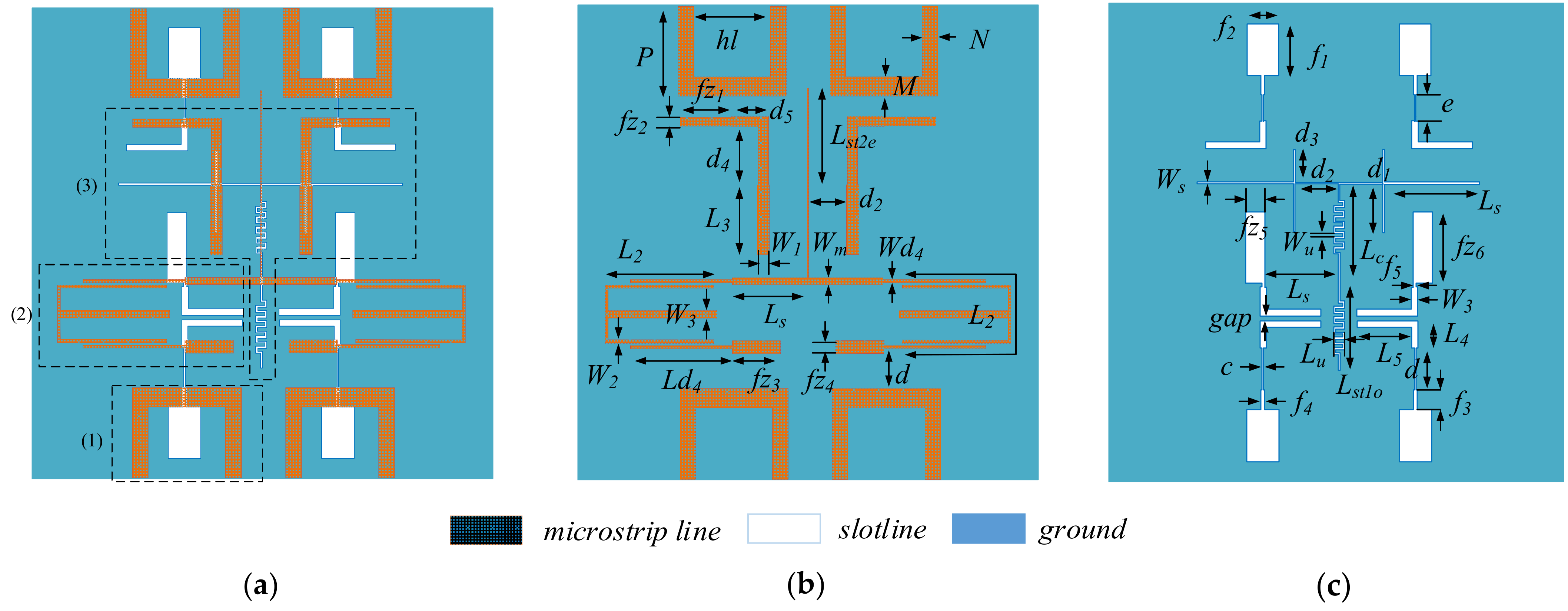


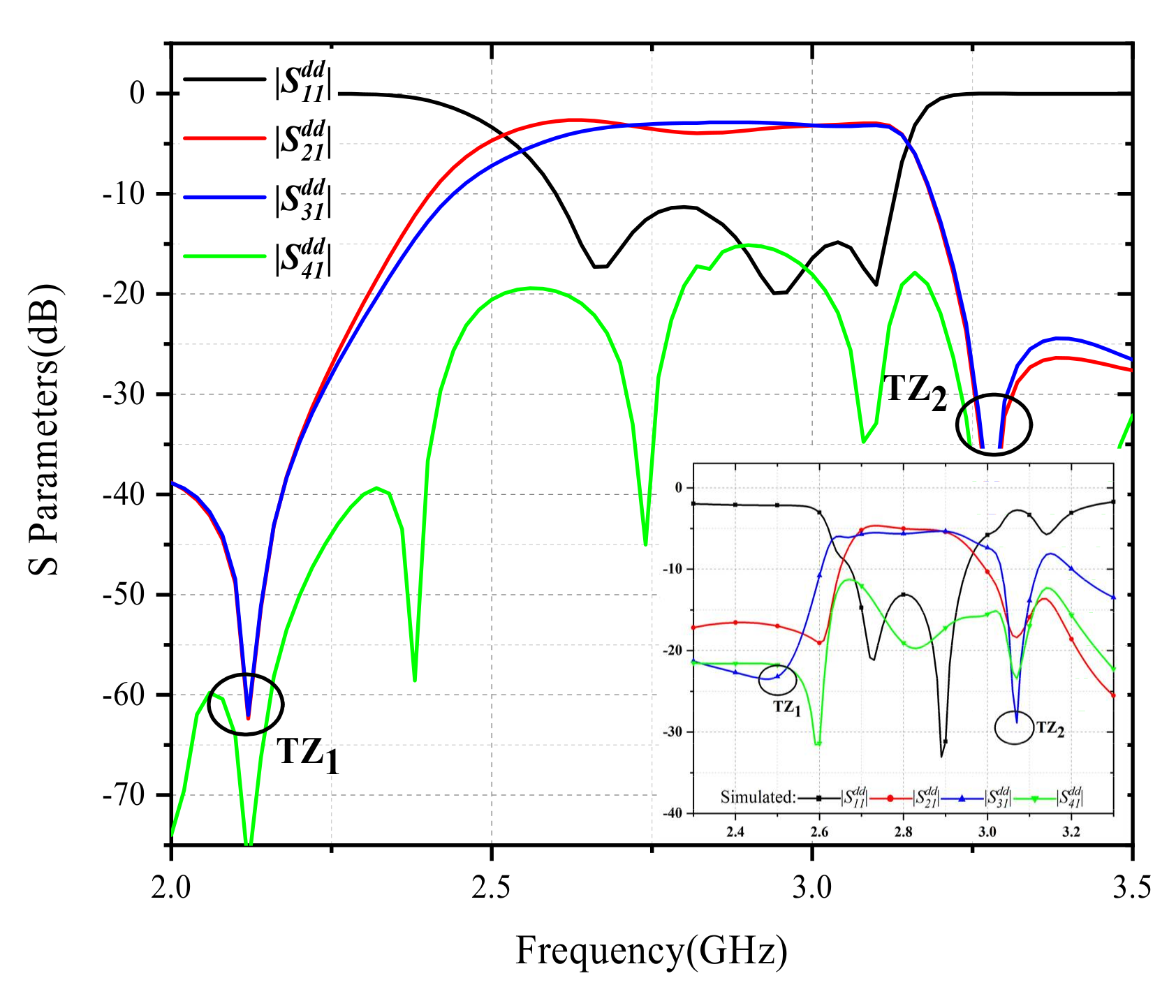



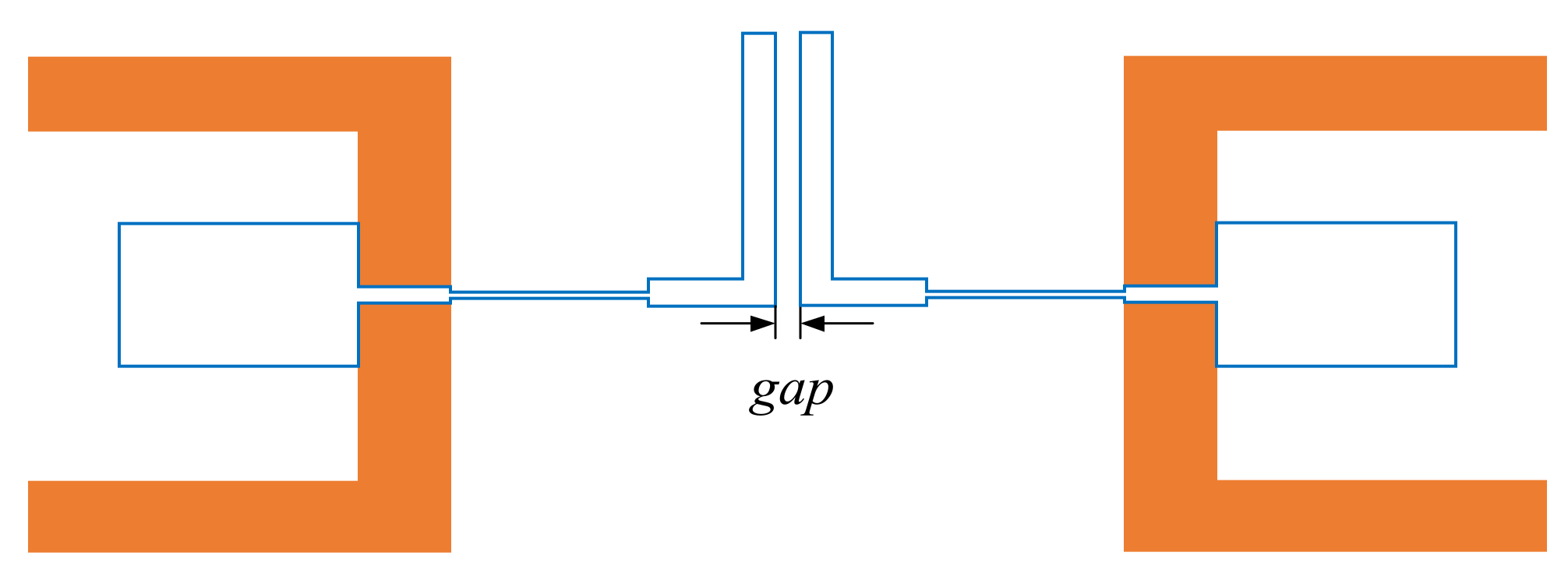


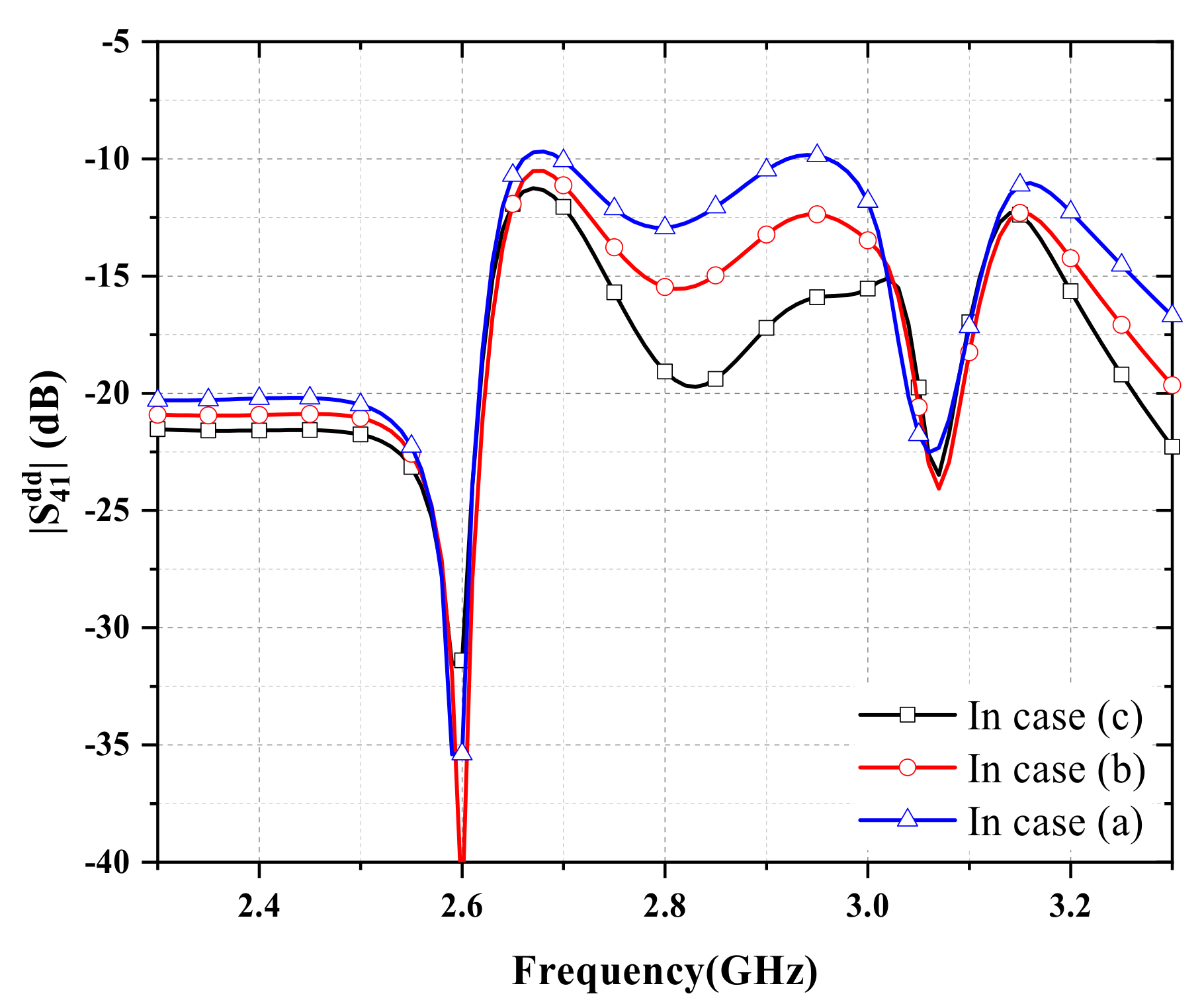
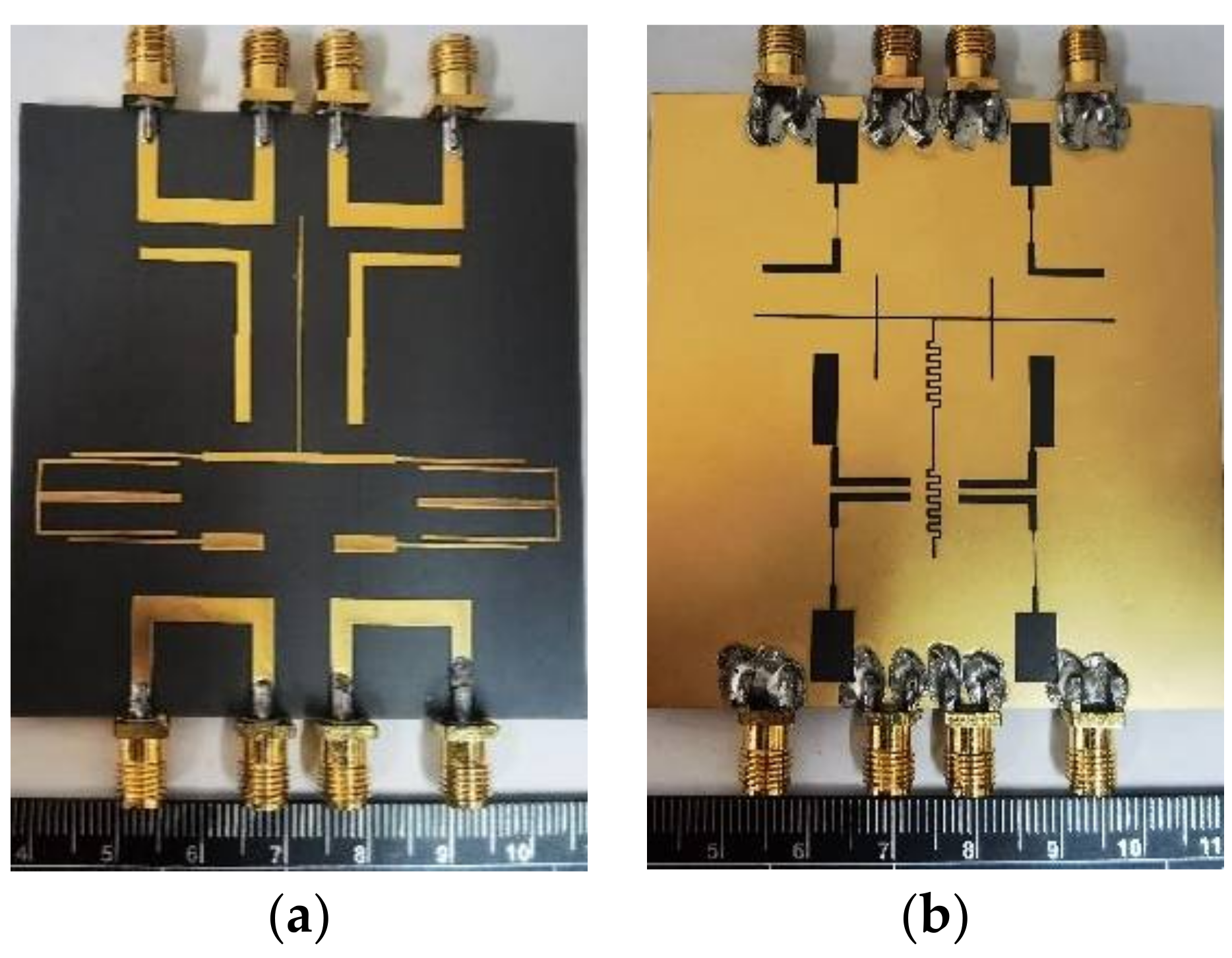

| Ref. | Freq (GHz) | BW (RL > 10 dB) | No. Of TZs | CM Absorption | ISO (dB) | CMS (dB) | Size (λg2) |
|---|---|---|---|---|---|---|---|
| [4] | 1.87/3.18 | 52 | 2 | NO | 28 | NO | 0.40 × 0.55 |
| [20] | 1.30/2.25 | 53 | 1 | NO | 25 | NO | 0.26 × 0.26 |
| [21] | 1.75/2.25 | 19 | 2 | YES | 20 | 20 | 0.86 × 0.62 |
| [22] | 1.90/2.10 | 15 | NO | NO | 25 | 40 | 0.88 × 0.21 |
| This Work | 2.30/3.30 | 12 | 2 | YES | 20 | 55 | 0.59 × 0.63 |
Publisher’s Note: MDPI stays neutral with regard to jurisdictional claims in published maps and institutional affiliations. |
© 2021 by the authors. Licensee MDPI, Basel, Switzerland. This article is an open access article distributed under the terms and conditions of the Creative Commons Attribution (CC BY) license (https://creativecommons.org/licenses/by/4.0/).
Share and Cite
Qiao, L.; Li, R.; Han, Y.; Wei, F.; Yang, Y.; Yang, X.; Wu, N. A Balanced Filtering Directional Coupler with Wide Common-Mode Suppression Based on Slotline Structure. Electronics 2021, 10, 2254. https://doi.org/10.3390/electronics10182254
Qiao L, Li R, Han Y, Wei F, Yang Y, Yang X, Wu N. A Balanced Filtering Directional Coupler with Wide Common-Mode Suppression Based on Slotline Structure. Electronics. 2021; 10(18):2254. https://doi.org/10.3390/electronics10182254
Chicago/Turabian StyleQiao, Luyan, Rui Li, Ying Han, Feng Wei, Yong Yang, Xiaoning Yang, and Nankai Wu. 2021. "A Balanced Filtering Directional Coupler with Wide Common-Mode Suppression Based on Slotline Structure" Electronics 10, no. 18: 2254. https://doi.org/10.3390/electronics10182254
APA StyleQiao, L., Li, R., Han, Y., Wei, F., Yang, Y., Yang, X., & Wu, N. (2021). A Balanced Filtering Directional Coupler with Wide Common-Mode Suppression Based on Slotline Structure. Electronics, 10(18), 2254. https://doi.org/10.3390/electronics10182254









